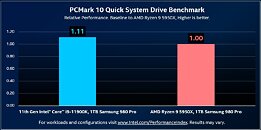- Joined
- Oct 9, 2007
- Messages
- 47,233 (7.55/day)
- Location
- Hyderabad, India
| System Name | RBMK-1000 |
|---|---|
| Processor | AMD Ryzen 7 5700G |
| Motherboard | ASUS ROG Strix B450-E Gaming |
| Cooling | DeepCool Gammax L240 V2 |
| Memory | 2x 8GB G.Skill Sniper X |
| Video Card(s) | Palit GeForce RTX 2080 SUPER GameRock |
| Storage | Western Digital Black NVMe 512GB |
| Display(s) | BenQ 1440p 60 Hz 27-inch |
| Case | Corsair Carbide 100R |
| Audio Device(s) | ASUS SupremeFX S1220A |
| Power Supply | Cooler Master MWE Gold 650W |
| Mouse | ASUS ROG Strix Impact |
| Keyboard | Gamdias Hermes E2 |
| Software | Windows 11 Pro |
Intel claims that its upcoming 11th Gen Core "Rocket Lake-S" desktop processors offer up to 11% higher storage performance than competing AMD Ryzen 5000 processors, when using the CPU-attached M.2 NVMe slot. A performance slide released by Intel's Ryan Shrout shows a Samsung 980 PRO 1 TB PCI-Express 4.0 x4 M.2 NVMe SSD performance on a machine powered by a Core i9-11900K processor, compared to one powered by an AMD Ryzen 9 5950X. PCMark 10 Quick System Drive Benchmark is used to evaluate storage performance on both machines. On both machines a separate drive is used as the OS/boot drive, and the Samsung 980 PRO is used as a test drive, free from any OS role.
The backup page for the slide provides details of the system configurations used for both machines. What it doesn't mention, however, is whether on the AMD machine, the 980 PRO was installed on the CPU-attached M.2 NVMe slot, or one that's attached to the AMD X570 chipset. Unlike the Intel Z590, the AMD X570 puts out downstream PCI-Express 4.0, which motherboard designers can use to put out additional NVMe Gen 4 slots. On the Intel Z590 motherboard, the M.2 NVMe Gen 4 slot the drive was tested on is guaranteed to be the CPU-attached one, as the Z590 PCH puts out PCIe Gen 3 downstream lanes. A PCI-Express 4.0 x4 link is used as chipset bus on the AMD X570, offering comparable bandwidth to the DMI 3.0 x8 (PCI-Express 3.0 x8) employed on the Intel Z590. A drive capable of attaining 7 GB/s sequential transfers should be in a sub-optimal situation on a chipset-attached M.2 slot. It would be nice if Intel clears this up in an update to its backup.
Update 02:51 UTC: In response to a specific question on Twitter, on whether the drives were tested on CPU-attached M.2 slots on both platforms, Ryan Shrout stated that a PCI-Express AIC riser card was used on both platforms to ensure that the drives are CPU-attached. 11% is a significant storage performance uplift on offer.



View at TechPowerUp Main Site
The backup page for the slide provides details of the system configurations used for both machines. What it doesn't mention, however, is whether on the AMD machine, the 980 PRO was installed on the CPU-attached M.2 NVMe slot, or one that's attached to the AMD X570 chipset. Unlike the Intel Z590, the AMD X570 puts out downstream PCI-Express 4.0, which motherboard designers can use to put out additional NVMe Gen 4 slots. On the Intel Z590 motherboard, the M.2 NVMe Gen 4 slot the drive was tested on is guaranteed to be the CPU-attached one, as the Z590 PCH puts out PCIe Gen 3 downstream lanes. A PCI-Express 4.0 x4 link is used as chipset bus on the AMD X570, offering comparable bandwidth to the DMI 3.0 x8 (PCI-Express 3.0 x8) employed on the Intel Z590. A drive capable of attaining 7 GB/s sequential transfers should be in a sub-optimal situation on a chipset-attached M.2 slot. It would be nice if Intel clears this up in an update to its backup.
Update 02:51 UTC: In response to a specific question on Twitter, on whether the drives were tested on CPU-attached M.2 slots on both platforms, Ryan Shrout stated that a PCI-Express AIC riser card was used on both platforms to ensure that the drives are CPU-attached. 11% is a significant storage performance uplift on offer.



View at TechPowerUp Main Site







